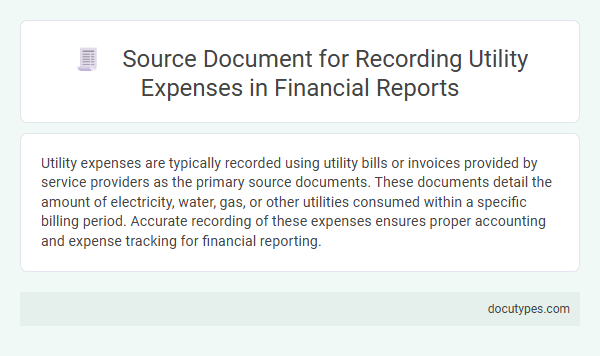Utility expenses are typically recorded using utility bills or invoices provided by service providers as the primary source documents. These documents detail the amount of electricity, water, gas, or other utilities consumed within a specific billing period. Accurate recording of these expenses ensures proper accounting and expense tracking for financial reporting.
Introduction to Source Documents in Utility Expense Reporting
Source documents are essential in accurately recording utility expenses in financial reporting. They provide verifiable evidence of transactions related to utilities such as electricity, water, and gas.
- Utility Bills - These official documents detail the amount of utilities consumed and the corresponding charges for a specified period.
- Payment Receipts - Receipts confirm that utility bills have been paid and serve as proof of financial transactions.
- Meter Reading Reports - Reports from utility meters provide data on consumption used to verify or estimate utility expenses.
Using these source documents ensures accurate and transparent recording of utility expenses in financial records.
Importance of Accurate Utility Expense Documentation
What source document is used for recording utility expenses? Utility bills serve as the primary source documents for recording utility expenses, providing detailed information on usage and charges. Accurate utility expense documentation ensures proper financial tracking and budgeting for your business operations.
Types of Source Documents for Utility Expenses
Source documents used for recording utility expenses include utility bills and invoices issued by service providers. These documents provide detailed information about the amount of electricity, water, gas, or other utilities consumed during a specific period.
Utility bills typically contain the account number, billing period, consumption details, and the total amount due, serving as primary evidence for expense recording. Invoices from utility companies also function as official records for verifying and authorizing payment transactions related to utility costs.
Key Information Captured in Utility Expense Source Documents
| Utility Expense Source Document | Key Information Captured |
|---|---|
| Utility Bills | Account number, billing period, total amount due, consumption details (kWh for electricity, cubic feet for gas, gallons or cubic meters for water), due date, service provider name, and customer name |
| Invoices from Utility Companies | Invoice number, issue date, payment terms, service address, breakdown of charges (base fees, usage fees, taxes, additional surcharges), and any adjustments or credits applied |
| Payment Receipts | Date of payment, amount paid, payment method, confirmation or receipt number, and any remaining balance |
| Meter Reading Reports | Meter identification number, date and time of reading, consumption values, and any noted anomalies or maintenance notes |
| Service Contracts or Agreements | Contract terms, rate schedules, service period, and provider contact information |
| Your Record Keeping | Ensuring accuracy by verifying information from source documents for proper utility expense recording |
Best Practices for Collecting Utility Expense Source Documents
Utility expense source documents typically include utility bills, payment receipts, and meter reading records. These documents provide verifiable evidence for recording and reconciling utility costs accurately within accounting systems. Best practices involve timely collection, organized filing, and cross-checking with usage data to ensure accuracy and prevent discrepancies.
Verification and Validation of Utility Expense Source Documents
Utility expenses are typically recorded using utility bills as the primary source documents. Verification and validation of these source documents ensure accuracy and proper authorization before recording.
- Utility Bills - These documents provide detailed charges for electricity, water, gas, and other utilities used by the organization.
- Verification Process - Involves checking the utility bill details against meter readings and contractual rates to confirm accuracy.
- Validation Procedures - Includes obtaining approval from authorized personnel and cross-referencing with previous bills for consistency.
Common Challenges in Utility Expense Source Documentation
Utility expense recording relies primarily on source documents such as utility bills, invoices, and payment receipts. Common challenges in managing these documents include inaccurate billing, missing records, and delayed receipt of statements. Ensuring your utility expenses are accurately documented requires careful verification and timely organization of these source documents.
Integrating Source Documents with Financial Reporting Systems
Utility expenses are recorded using utility bills as primary source documents. These bills provide detailed information about consumption, billing periods, and charges.
Integrating utility bills with financial reporting systems ensures accurate expense tracking and timely data entry. Your accounting software can automatically import and categorize these documents to streamline financial processes.
Regulatory Compliance for Utility Expense Documentation
Utility expense recording relies on source documents such as utility bills, invoices, and payment receipts. These documents provide detailed information about consumption, charges, and payment dates.
Regulatory compliance requires maintaining accurate and verifiable utility expense documentation to meet audit and tax standards. Utility bills serve as primary evidence for expense deductions and financial reporting. You must ensure all utility-related documents are organized and accessible for review by regulatory authorities.
What Source Document Is Used for Recording Utility Expenses? Infographic

